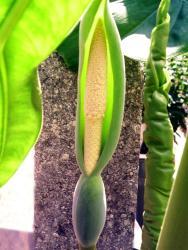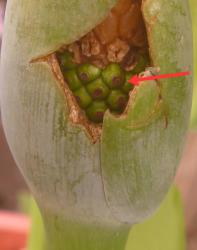Warning: I'm a general plant newbie and this container Alocasia odora is my first and only aroid.
It's been growing well, and last week I noticed an inflorescence shooting up. From the web, I get top to bottom appendix, male, sterile, female (respectively), with a restriction blocking the female at least so only authorized natively pollinating beetles(?) can transfer pollen - and perhaps only at the right time and from non-self males (possible physical or temporal blocks to self-fertilization).
So for fun, as per some online notes, cut open the restriction so as to, maybe, permit pollen from the top to reach the female flowers at the bottom. After the spathe opened, and lacking knowledge to recognize if either male or female were ready, I washed or brushed the spadix from the top down on about three consecutive days.
Today I noticed the female area had greened (last photo). Would you know if this change means that they were fertilized? Or perhaps that they are only now receptive? Or ?
There's a second inflorescence on the way. So I have a second chance... Any other suggestions for such assisted reproduction would be appreciated.







